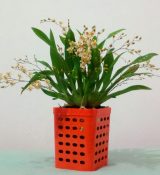Monthly Care Guide: Phalaenopsis
Author: Celeste BoothNo Comments
Care and Culture, Growing Indoors

Below is an overview of the general care requirements throughout the year. Simply scroll down to the current month for the most accurate information, or bookmark/print this page for future reference throughout the year. For general care requirements for Phalaenopsis orchids (humidity levels, light requirements, and more), please refer to our popular Phalaenopsis Care Cheat Sheet.
January – February
Your Phalaenopsis orchids are getting ready to bloom – and early ones may have already begun! During this budding/blooming period it is important to work gently and not to break off or disrupt the flowers during watering, staking, etc.
REMEMBER: Stake your orchids in preparation for their blooming, if they are not already.
AVOID: Do not re-pot your orchid while it’s blooming.
March – April
Your orchid is now in peak blooming time, so make sure your flower stems are staked properly. As the days begin to get longer, pay attention to the fact that your orchid may start needing more frequent watering. You may remove spent blooms as you see fit.
REMEMBER: Flowering orchids can also mean pesky pests. Check regularly for any infestation as catching it early will give you much greater odds of rescuing your plant.
AVOID: Chemical pest treatments on flowers may damage or cause them to drop. Treat pest problems early and naturally, if possible. See our Orchid Pest Guide for more.
May – June
Flowering is done and now is the time to re-pot your orchid (if needed). The best time to do this is when the roots are showing new growth. Re-pot them in their new, clean potting media, and trim away any rotten or soft roots.
REMEMBER: Regular watering and fertilization during this period will help your orchid re-bound from the potting and keep growing healthy.
AVOID: Although extra watering is needed during the hot summer months, avoid splashing water as water-borne illnesses can be a problem with Phalaenopsis orchids.
July – August
Repotting should be finished and your orchid should just be focused on growth. As the leaves and roots grow, your orchid is also preparing its potential for the next flowering season.
REMEMBER: Summer is in full swing, so be sure to keep those orchids watered and fed!
AVOID: Do not neglect your orchids if you’re going out of town on vacation – find someone who can help water them while you’re gone.
September – October
As the days begin to shorten and temperatures start to drop, pay attention to watering and feeding amounts (reduce as needed). An extra bit of bloom-boosting fertilizer can be beneficial during this time, as your orchid is sending out those first spikes.
REMEMBER: Moving your orchid to a warmer location, or heating at night, may be necessary for those in cold climates.
AVOID: Cooler temps mean less frequent watering — do not overwater as this can cause root rot.
November – December
Cooler temps and shorter days mean your Phalaenopsis knows blooming season is around the corner and you will start to see signs of these changes. Reduce Nitrogen levels and boost Potassium and Phosphorus to help grow those beautiful blooms.
REMEMBER: Now is the time to start checking for any pest infestations. A copper-based compound can be used to treat rot problems.
AVOID: High Nitrogen levels in your fertilizer.


Ask an Expert
Questions about orchids?
Our experts love a challenge!
Photo of the Week
Submit your photo to be featured on the blog!
More Photo of the Week Winners
Submit Photo







